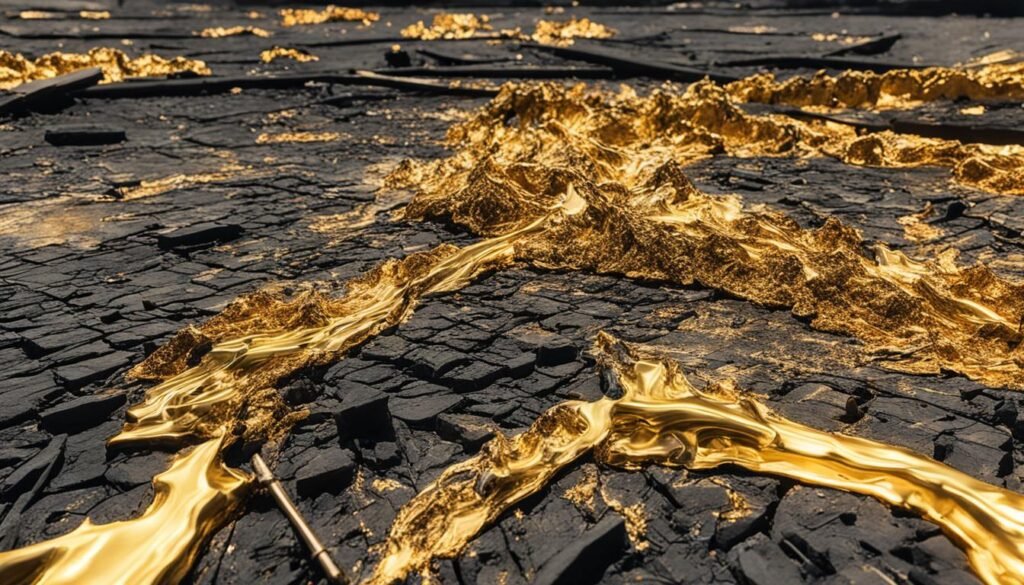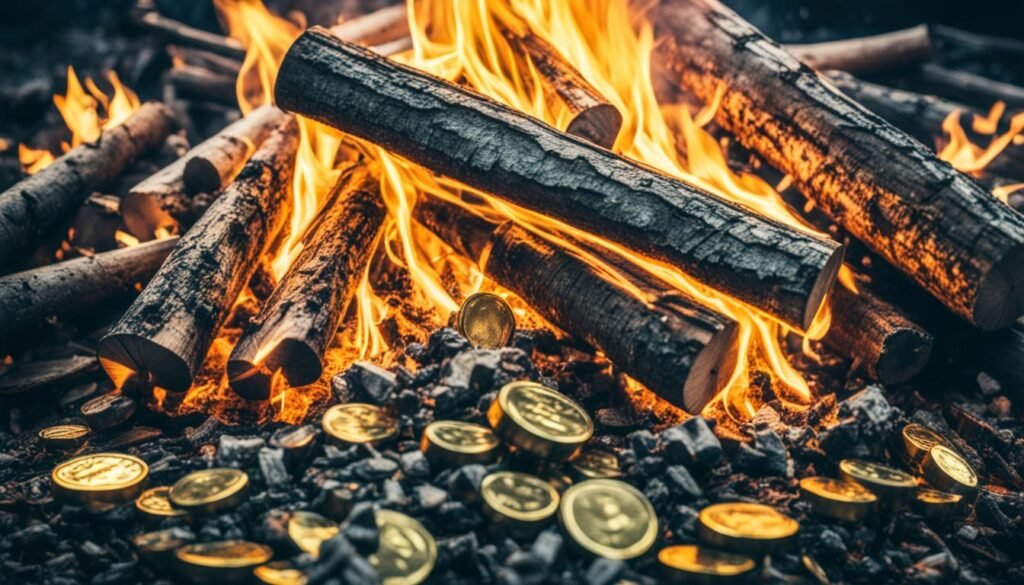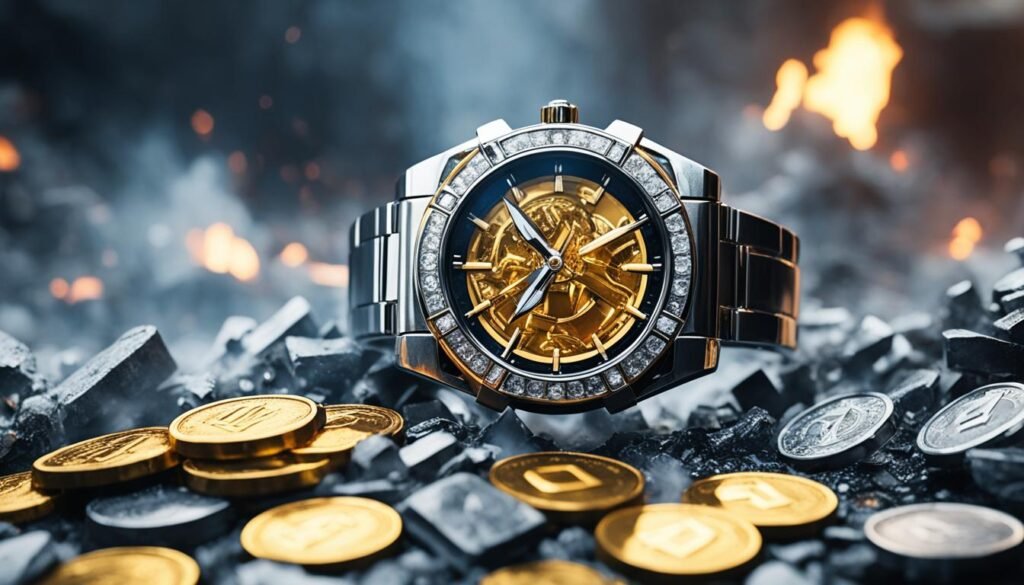Have you ever thought about whether gold can survive a house fire’s intense heat?
House fires are very destructive, often leaving homes in ruins. Yet, certain items stand a better chance, like gold, silver, diamonds, and steel.
These items have a better chance because they don’t easily melt. Also, they keep their shape well under high heat. This makes them good for those who wish to protect their valuables in case of a fire.
Key Takeaways about Can Gold Survive a Fire
- House fires can reach temperatures between 1,000 and 2,000 degrees Fahrenheit.
- Gold resilience is due to its high melting point and structural integrity.
- Precious metals like gold and silver are more likely to survive a house fire.
- Knowing about fireproof precious metals can help safeguard valuable possessions.
- Investing in protective storage solutions can further enhance gold survival in fires.
The Basics of Gold’s Melting Point
It’s key to know how well precious metals handle heat. This helps us see if they’ll last in things like fires. We’ll look at how gold’s melting point stands up to other metals.
Understanding Melting Points
The melting point shows us when a solid metal turns to liquid. High melting points mean metals can take a lot of heat, making them last longer. Gold’s point is at a high 1,950 degrees Fahrenheit, surviving the heat of a common house fire pretty well.
Gold Compared to Other Metals
Let’s compare gold to metals like silver and steel. Silver melts at 1,700 degrees Fahrenheit, showing it might not be as heat-tough as gold. Steel, on the other hand, melts at a very high 2,500 degrees Fahrenheit, but still, gold’s durability is impressive.
| Metal | Melting Point (°F) |
|---|---|
| Gold | 1,950 |
| Silver | 1,700 |
| Steel | 2,500 |
Average Temperatures in House Fires

Common house fires are very hot, from 1,000 to 2,000 degrees Fahrenheit. These house fire temperatures can burn most things in a home. But there are some materials that can last in such extreme heat.
Temperature Range in House Fires
Fires in homes can get very, very hot. They range from 1,000 to nearly 2,000 degrees Fahrenheit. This heat is higher than water’s boiling point and can quickly burn everything. Knowing what can survive this heat is important.
Materials Likely to Survive
Some materials can last in a fire because they melt at very high temperatures. Take gold and silver in fires, for example. They melt at around 1,950 and 1,700 degrees Fahrenheit. Steel is even tougher, not melting until it’s about 2,500 degrees Fahrenheit. With the right protection, these materials have a good chance of making it through a fire.
Behavior of Precious Metals in Fires
Precious metals like gold and silver act different in fires. They stay solid at very high temperatures because of their thermal resistance. Their chances of surviving increase if they’re kept in fireproof containers. The strength of these metals is key to their ability to withstand fires.
Can Gold Survive a Fire?
Gold is famous for its high melting point, at 1,950 degrees Fahrenheit. This makes it very resistant to heat in house fires. Thanks to this, there’s a good chance gold can make it through a fire.
Buy Gold Online: The Smart and Secure Way
Discover the safest and most reliable strategies to buy gold online. Make informed investment decisions and secure your financial future today!
Learn MoreThe gold fire safety idea depends a lot on how hot and how long the fire is. A quick, not too hot fire might not harm the gold much. But a really hot, long-lasting fire could ruin its looks.
How gold is stored matters a lot too. Gold in a fireproof safe is more likely to stay shiny. But gold that’s out in the open, like jewelry, might get more beat up.
Knowing all this, choosing the right place to store your gold is crucial. Even after a fire, gold’s hardiness and ability to not easily tarnish keep it as a valuable possession.
Impact on Gold Condition and Value Post-Fire

When gold items are in a fire, their outer layer can badly change. This makes them look different and might reduce how much they’re worth. Looking at gold after a fire, we see if it’s lost its texture, changed color, or deformed due to high heat.
Surface Damage from Extreme Heat
Extreme heat can make gold pieces look less shiny and deformed. How bad the damage is depends on how long and how hot the fire was. Even when gold doesn’t actually melt, it can get pretty messed up and needs an expert to check it out.
Locating Gold in Fire Debris
After a fire, finding gold is tough because of all the stuff that’s burnt. It’s key to check the damage carefully to spot any gold that can be saved. You need special tools and safety gear to look through the mess safely and find valuable pieces.
Effect on Bullion and Coins
Being in a fire lowers the value of gold coins and bullion a lot. How much it drops depends on how damaged they are and their condition after the fire. Coins might not look as good as before, but they can be made better with refinishing.
Getting the gold out right after a fire can help reduce the loss in value. But it’s still likely their market price will drop. So, it’s good to be prepared for this when looking at a recovery plan.
| Aspect | Impact | Remarks |
|---|---|---|
| Surface Damage | Discoloration and Warping | Depends on heat exposure duration |
| Locating Gold | Challenging | Specialized tools required |
| Bullion Value Impact | Potential Decrease | Determined by condition and recovery efforts |
Factors Contributing to the Resilience of Gold

Gold stays strong in fires because of its unique features. It doesn’t react much and can handle high heat. This keeps it from damage, even when things get really hot.
Its high melting point is key. It stays solid until it hits 1,950 degrees Fahrenheit. This is much hotter than most fires at home. Keeping gold in a fire-resistant safe is smart. It helps keep it safe and solid as an investment.
Storing gold right is important for its endurance. Fire-resistant safes add extra protection. This means you don’t have to worry much. Investors can trust gold to withstand tough times, making it a secure choice.
| Gold Property | Impact on Resilience |
|---|---|
| Non-reactivity | Prevents tarnishing and degradation |
| High Thermal Conductivity | Allows it to withstand extensive heat without losing integrity |
| Melting Point (1,950°F) | Ensures survival even at temperatures higher than typical house fires |
| Proper Storage (Fire-resistant safe) | Enhances the chances of the gold remaining intact and unscathed |
Together, these points show why gold is so reliable. It can last through tough times that might ruin other assets.
Other Valuable Items That Survive Fires

When a fire rages, some items have a better chance of staying safe. Gold, diamonds, and steel do well in fires. They can endure high heat without getting damaged.
Survival of Diamonds
Diamonds are known for more than their beauty. They’re incredibly strong and can handle a lot of heat. With a melting point at 6,000 degrees Fahrenheit, they often survive fires. This high heat tolerance makes diamonds very strong when it comes to fire safety.
Steel Tools and Cookware
Items made from steel are also good in fires. They can keep their shape up to about 2,500 degrees Fahrenheit. While they might change shape in a fire, they can resist serious heat. This means steel tools and cookware stay useful even after a fire strikes.
| Material | Melting Point (°F) | Fire Resistance |
|---|---|---|
| Diamond | 6,000 | High |
| Steel | 2,500 | Moderate to High |
Conclusion
In a terrible house fire, some things can still give us hope. Gold is one of these because it doesn’t easily burn. This makes it a good choice for keeping your money safe even during a fire.
Looking into why gold is so strong against fire shows us something important. By knowing this, we can better take care of our valuable things. This means even after a fire, our special items can still be valuable.
Gold and similar items help us feel more ready if a fire happens. This story reminds us that not everything is lost in a fire. Protecting gold and other strong valuables can help us bounce back from big losses.
FAQ about Can Gold Survive a Fire
Can gold survive a fire?
Yes, gold can survive a fire. Its high melting point is 1,950 degrees Fahrenheit. This is above the temperatures of most house fires, from 1,000 to 2,000 degrees Fahrenheit.
What is gold’s melting point compared to other metals?
Gold melts at 1,950 degrees Fahrenheit. Silver, at 1,700 degrees, and steel, at 2,500, are also quite resistant. This means they can endure the heat of fires.
What is the average temperature range in house fires?
A house fire’s heat ranges from 1,000 to 2,000 degrees Fahrenheit. This is hotter than the boiling point of water.
How do precious metals behave in fires?
Metals like gold and silver are tough against heat because they melt at high temperatures. How well they survive a fire also depends on how they were stored.
Can the condition of gold be affected post-fire?
Extreme heat can damage the surface of gold items. It may reduce their value. The process of cleaning and reshaping them can also influence their worth.
What factors contribute to the resilience of gold?
Gold’s ability to resist fire comes from its high melting point and inert behavior. Using fire-safe storage further protects it.
What other valuable items can survive house fires?
Diamonds and steel items can also make it through a fire. Diamonds need over 6,000 degrees to melt. Steel’s melting point is around 2,500 degrees.
